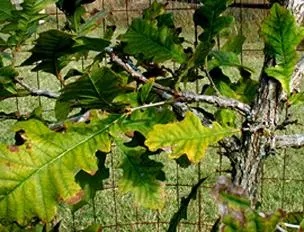NICE! Plant of the Month
Quercus macrocarpa

Family: Fagaceae – Beech Family
Other Common Names: Burr Oak, Mossy Cup Oak, Savannah Oak
Type: Large tree
Natural Habitat: Stream bottoms and slopes in North and East Central Texas.
Growth: Upwards of 80 feet. Spread is usually 40 feet or more.
Deer Resistance: No, like most trees, must be protected while in browsing height.
Wildlife: Tree is utilized by wide range of wildlife from mammals to songbirds, ground birds and insect eating birds. Acorns are also eaten by wildlife.
Light Tolerance: Sun, part-shade, shade.
Flowers: In Spring March -May. Yellow, green or brown blooms.
Fruit: Matures in the Fall. 1 inch or larger acorns in moss like fringed cups. Largest acorns of the oak trees.
Leaves: Dark green above, grayish-green underside, 4-10 inches long and half as wide with variant deeply cut smooth lobes. Easy to rake because of large size.
Water Requirements: Low. One of the most drought resistant oaks.
Soil Requirements: Can withstand a wide range of conditions. Usually found on limestone or calcareous clay. Best growth is in deeper soils. Sensitive to root zone disturbance caused by construction.
Planting Instructions: Space trees at least 20-30 feet apart. Dig a hole at least two times wider than, but the same depth as the root ball in the nursery container. Sides of the hole should be irregular, not smooth. Remove plant from container, taking care to support the root ball. Loosen exterior roots gently with your fingers. If the plant is root-bound and cannot be loosened by hand, the outer roots may be cut in several places. Lift the plant by the root ball and place into the hole. Backfill hole, using soil that was dug out.. Do not add any soil to the top of the root ball. Gently firm the soil with your hands, but do not tamp it down. Place 3-4 inches of mulch over the bare soil around, but not touching the base of the plant.
Watering Instructions: Water deeply after planting to settle soil around roots. Then every 7-10 days, as needed, during the first growing season. Before watering, check for soil moisture at a depth of an inch or two at the edge of the root ball. Skip a watering after a rainfall of ½ to 1 inch. Maintain this watering schedule until the first fall. Reduce watering during the cool fall and winter months. In a “normal” year, no watering may be necessary during the fall and winter, but during a dry period, monthly watering may be needed. Second Spring and thereafter: Water monthly only during periods of drought. Once established, natives will survive with little supplemental irrigation.
NICE! Tip: The Bur Oak is a stately, relatively fast-growing, long-living oak tree. Its resistance to oak wilt, drought tolerance and beauty make it an ideal candidate as a shade tree in a park setting. Spacing closer than 20-30 feet would produce a woodsy rather than a park like feel.
Look for the NICE! Plant of the Month signs and information sheets on your next visit to a participating Boerne nursery. And thank you for supporting native plants by using them in your landscapes.
